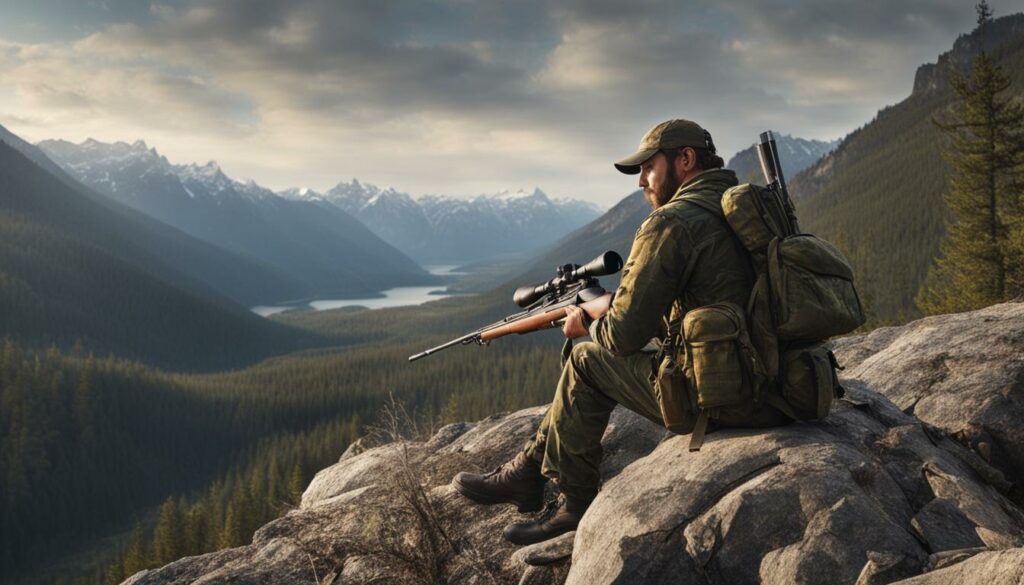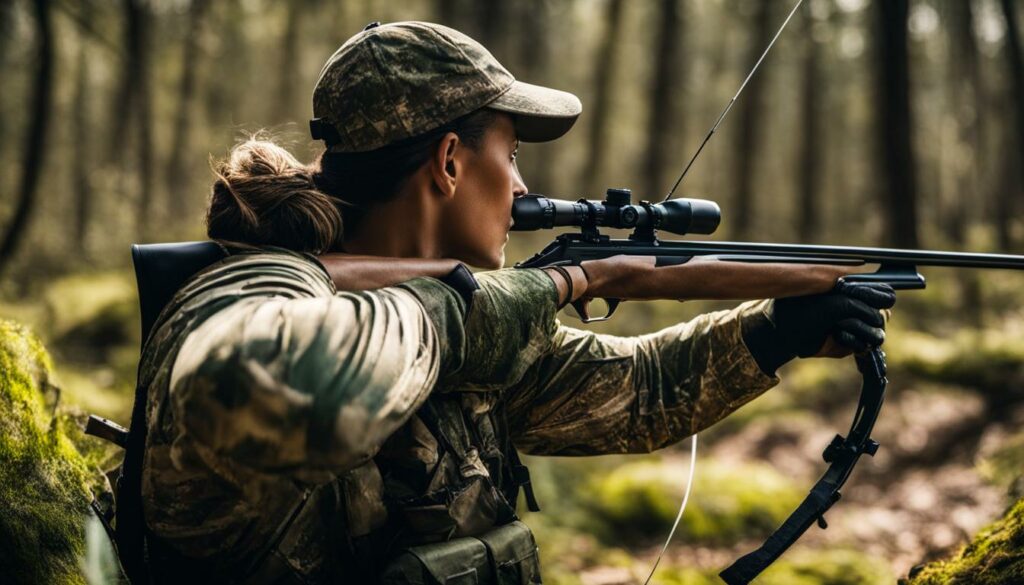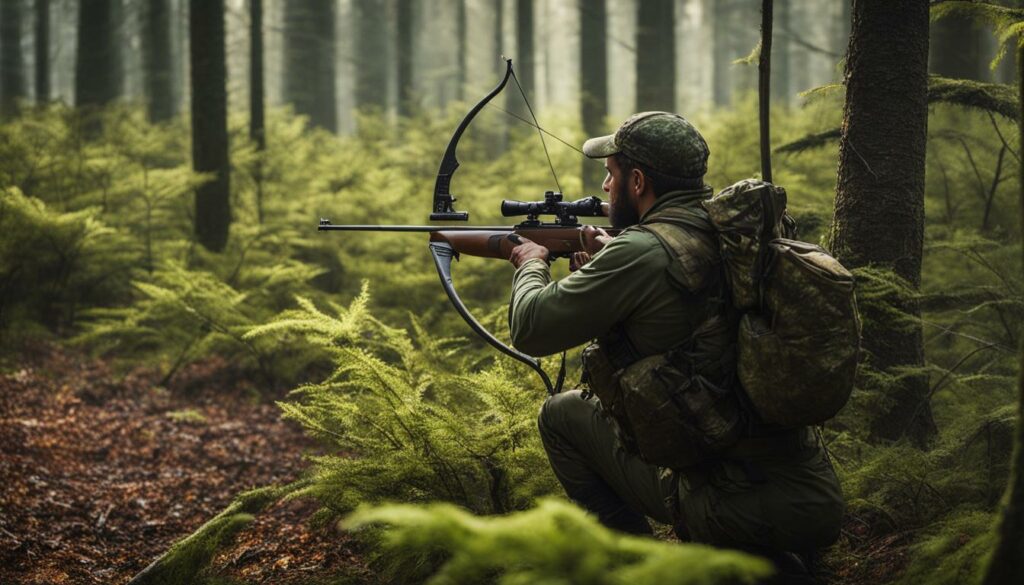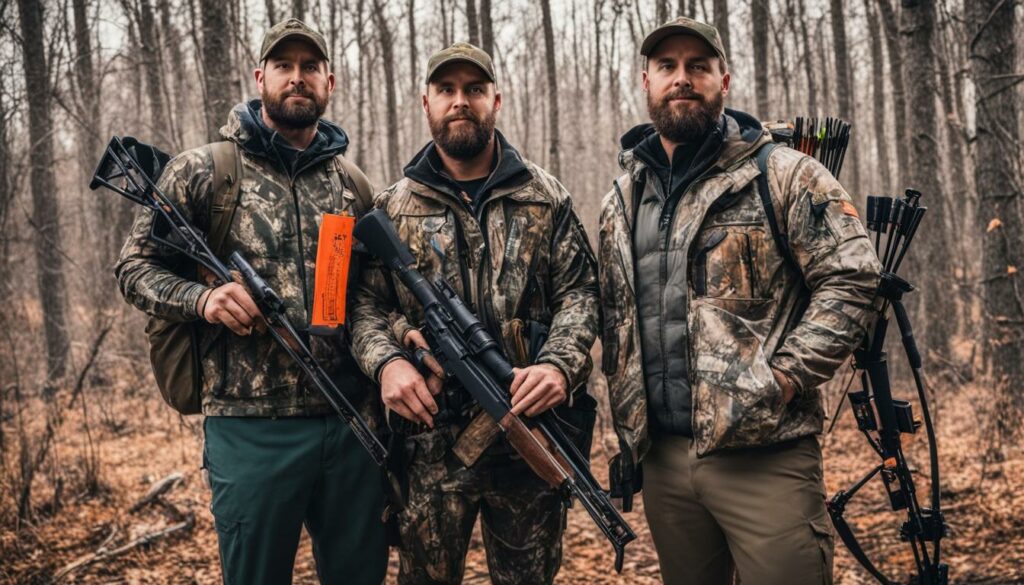When choosing between bowhunting and rifle hunting, several factors must be considered. Bowhunting offers unique advantages, such as increased hunting seasons and quieter hunting experiences.
It allows hunters to get closer to their target, requiring patience and accurate shot placement within a range of 10-50 yards. Bowhunting also provides opportunities for hunting a variety of game, including big game animals like elk, turkey, bear, and grouse.
Rifle hunting, on the other hand, offers distinct benefits. Rifles enable hunters to harvest game at longer distances, typically 50-300 yards, extending their effective range. With the use of scopes, rifles allow for precise shot placement, contributing to a higher success rate.
The Pros of Rifle Hunting
Rifle hunting offers several advantages for avid hunters. From improved accuracy to increased range and accessibility, rifles provide unique benefits that make them popular for many hunting enthusiasts.
One significant advantage of rifle hunting is harvesting game at longer distances. Rifles typically range 50-300 yards, allowing hunters to take precise shots from a safe distance. This increased range gives hunters a greater chance of success, especially when targeting elusive or skittish prey.
Rifles facilitate precise shot placement through the use of scopes. These optical devices provide hunters with enhanced target visibility and crosshair aiming, ensuring accurate and ethical shots. The combination of rifles and scopes results in a higher success rate and minimizes the game’s risk of injury.
Furthermore, rifles are powerful weapons that can effectively take down big games. Their greater energy and velocity make them capable of delivering lethal shots, enhancing the chances of a clean and humane kill. This is particularly advantageous when hunting larger animals requiring greater stopping power.
Compared to bows, rifles are generally less physically demanding to shoot. While archery requires considerable strength and technique to draw and release a bowstring, rifles rely on fundamental marksmanship skills.
This accessibility makes rifle hunting suitable for a wider range of hunters, including those with physical limitations or limited upper body strength.
However, it is essential to note that rifle hunting has certain limitations. In some areas, hunting seasons may be shorter for firearm use, and specific hunting districts may restrict firearm use. Hunters must comply with local regulations and seek appropriate permits and licenses for rifle hunting.
The Cons of Rifle Hunting
While rifle hunting offers various advantages, there are also specific challenges and downsides to consider when opting for this method. It’s important for hunters to fully understand the limitations before making a decision. Below are some of the critical factors to keep in mind:
1. Access and Practice Requirements
Rifle hunters need access to suitable hunting locations or designated gun ranges for regular practice. Spaces where long-range shooting is permitted, typically up to a minimum distance of 200 yards, are crucial. Without proper practice and familiarization with the firearm, accuracy, and safety can be compromised.
2. Restrictions and Limited Seasons
Rifles may be more restricted in certain hunting districts than other hunting methods. There may be limited hunting seasons specifically for rifle hunting, or specific areas might have regulations prohibiting or restricting firearm use. Therefore, rifle hunting enthusiasts might face more limitations and reduced opportunities in hunting locations and timing.
3. Higher Costs
Rifle hunting often comes with higher costs compared to other hunting methods. From the initial investment in a mid-level, big-game rifle and quality optics to ongoing expenses for ammunition, gear, and accessories – the overall financial commitment can add up. This can pose a challenge for hunters on a tight budget or those who prefer a more cost-effective approach to hunting.
Despite these challenges, many hunters find rifle hunting a rewarding and efficient method for harvesting game. It offers an extended effective range, increased accuracy, and accessibility to a wider range of hunters.
When deciding on the most suitable hunting method, each individual’s preferences, hunting goals, and available resources should be carefully considered.

The Pros of Bowhunting
Bowhunting offers several unique advantages. One of its main appeals is the longer hunting seasons, which typically overlap with the peak elk rut in Western states. Bowhunters do not need much space to practice, as their effective range is usually within 10-50 yards.
This method also allows for quieter hunting, as arrows are quieter than firearms, and it eliminates the need for recurring costs associated with bullets and shots. Bowhunting is not limited to big game; it also offers opportunities to hunt other species like turkey, bear, and grouse.

| Advantages | Description |
|---|---|
| Longer hunting seasons | Bowhunters enjoy extended hunting opportunities, especially during the peak elk rut in Western states. |
| Compact practice space | The effective range of a bow is typically within 10-50 yards, allowing for practice in smaller areas. |
| Quieter hunting | Arrows produce less noise than firearms, making bowhunting quieter and potentially stealthier. |
| Eliminates recurring ammunition costs | Bowhunters do not need to purchase bullets or shotgun shells, reducing the overall cost of the sport. |
| Versatile hunting opportunities | Bowhunting extends beyond the big game, offering opportunities for hunting turkey, bear, grouse, and other species. |
The Cons of Bowhunting
While bowhunting certainly has its advantages, there are also some challenges and limitations to consider. Bowhunters face unique obstacles that require patience, skill, and precision. Here are some downsides of bowhunting:
1. Getting Close to Big Game
Bowhunters must rely on getting within a relatively close range of their target, typically between 10 and 50 yards. This requires a deep understanding of the animal’s behavior and the ability to approach stealthily and remain undetected. It can be a difficult task that demands exceptional skill and patience.
2. Equipment Maintenance
Bowhunting equipment, such as bows and arrows, require regular maintenance. Bowstrings, in particular, need to be replaced every few years to maintain optimal performance.
Additionally, bow components can sometimes break, requiring repairs or replacements. Proper care and maintenance are essential to ensure the equipment is in top condition for a successful hunt.
3. Preservation of Game Meat
Bowhunting during archery season, especially in hotter regions, presents additional challenges when preserving game meat. Without the immediate throbbing shock and massive tissue damage caused by high-velocity rifle bullets, it’s crucial to take extra care to prevent spoilage and bacterial growth.
Cooling techniques, proper field dressing, and quick processing become even more critical to preserve the quality and safety of the harvested game meat.
Despite these challenges, many dedicated bowhunters find great satisfaction in the pursuit and enjoy the additional skills and experiences that come with bowhunting.

| Downsides of Bowhunting | Solutions |
|---|---|
| Getting close to big game is challenging | Develop stealth and camouflage skills, study animal behavior, and practice patience for effective close-range hunting. |
| Bowhunting equipment requires regular maintenance | Properly maintain and inspect your bow and arrows, including regular string replacements and repairs as needed. |
| Preserving game meat during archery season | Implement proper field dressing techniques, cool the carcass promptly, and process the game meat quickly to ensure its fresh, high-quality state. |
Comparing Costs: Rifle Hunting vs. Bowhunting
The financial aspect is important when choosing between rifle hunting and bow hunting. Let’s look at the costs associated with each method to help you make an informed decision.
Rifle Hunting Expenses
Regarding rifle hunting, the average cost of a mid-level, big-game rifle ranges from $750 to $1,500 or even higher. Scopes, an essential accessory for accurate shooting, often come with a hefty price tag, costing as much as the rifle.
You can expect to spend around $60 for ammunition for a box of 20 cartridges. In addition, you’ll need gun cleaning kits, trigger locks, and, optionally, a gun safe for proper maintenance and storage.
Bowhunting Expenses
The average cost of a mid-level compound bow used for bowhunting is similar to that of a rifle, ranging from $750 to $1,250. However, there are additional expenses to consider.
Bowhunting requires various accessories, such as pin sights, stabilizers, and releases, which can add to the overall cost. You’ll also need arrows, broadheads, and practice targets for regular training and practice sessions.

Now that you understand the cost considerations better continue reading to explore other aspects of bowhunting and rifle hunting to help you make the best decision.
Making the Choice: Bowhunting vs Rifle Hunting
When choosing between bowhunting and rifle hunting, several factors must be considered. The decision ultimately depends on personal preferences, access to suitable hunting locations, local regulations, budget, commitment level, and hunting goals.
Rifle hunting is often favored by novice hunters due to its higher chance of success, particularly for filling the freezer in the first few years. It provides a gateway to other types of firearm hunting and can be passed down through generations as a family tradition.
On the other hand, bowhunting appeals to those seeking a challenge and appreciating the traditional method. It also offers the opportunity to enjoy the exercise involved in drawing and shooting a bow, creating a unique hunting experience.
Bowhunting enthusiasts also benefit from longer hunting seasons, often overlapping with the peak elk rut in Western states. This extended season provides more opportunities to pursue games and potentially encounter less competition than rifle hunting.
Additionally, bowhunting allows hunters to participate in archery competitions and other recreational activities, allowing them to expand their skills and connect with a broader community of archers.
Comparison Table: Bowhunting vs Rifle Hunting
| Considerations | Bowhunting | Rifle Hunting |
|---|---|---|
| Effective Range | 10-50 yards | 50-300 yards |
| Shot Placement | Requires precision | Allows for greater accuracy with scopes |
| Noise | Quieter than firearms | Louder than bows |
| Hunting Seasons | Longer overlapping with elk rut | Shorter |
| Physical Demands | Requires more strength and practice | Less physically demanding |
| Access to Hunting Locations | May require less space for practice | Requires gun ranges or designated hunting areas |
| Cost | Similar to rifle hunting | Additional costs for ammunition and accessories |
Conclusion
When it comes to choosing between bowhunting and rifle hunting, it ultimately boils down to personal preference and individual hunting goals. Both methods have their advantages and considerations, offering unique experiences in the world of hunting. To make an informed decision, it is advisable to try both and gain first-hand experience.
Engaging with local hunting communities and seeking guidance from experienced hunters can provide valuable insights and advice. Participating in shooting and archery events can also enhance your skills and help you understand the nuances of each method.
Regardless of your choice, always prioritize safety guidelines and ethical hunting practices. Good luck on your hunting journey, whether you pursue the challenge and tradition of bowhunting or opt for the effectiveness and accessibility of rifle hunting.
FAQ
What are the advantages of rifle hunting?
Rifle hunting offers a longer effective range, precise shot placement with the help of scopes, and the ability to take down big games more quickly. It is also less physically demanding to shoot compared to bows.
What are the considerations for rifle hunting?
Rifle hunters need access to suitable practice spaces, must abide by hunting seasons and district restrictions, and may incur higher costs for ammunition and firearms.
What are the benefits of bowhunting?
Bowhunting offers longer hunting seasons, quieter hunting, and the elimination of recurring ammunition costs. It also allows hunting various species and appeals to those seeking a challenge and enjoying the traditional method.
What challenges are associated with bowhunting?
Bowhunters need to get closer to the game, requiring patience and skill. Bowhunting equipment may require regular maintenance, and during archery season in hot regions, it requires extra care in preserving game meat.
How do the costs compare between rifle hunting and bowhunting?
Both methods have similar costs for mid-level equipment. Still, rifle hunting may incur additional expenses for scopes and ammunition, while bowhunting requires accessories like pin sights, arrows, and practice targets.
How can one decide between bowhunting and rifle hunting?
The choice ultimately depends on personal preferences, hunting goals, access to suitable locations, local regulations, budget, and commitment level. Trying both methods and seeking guidance from experienced hunters can provide valuable insights.
What is the conclusion on the bowhunting vs rifle hunting debate?
The decision between bowhunting and rifle hunting is a personal choice that should consider the advantages, challenges, costs, and one’s hunting goals. Both methods have merits and considerations, and it is advisable to gain experience and engage with the hunting community before deciding.
